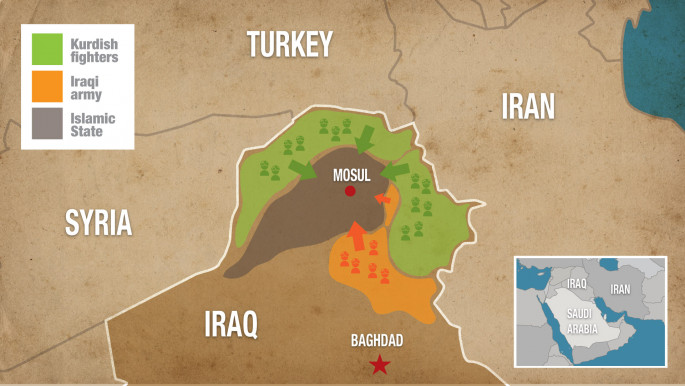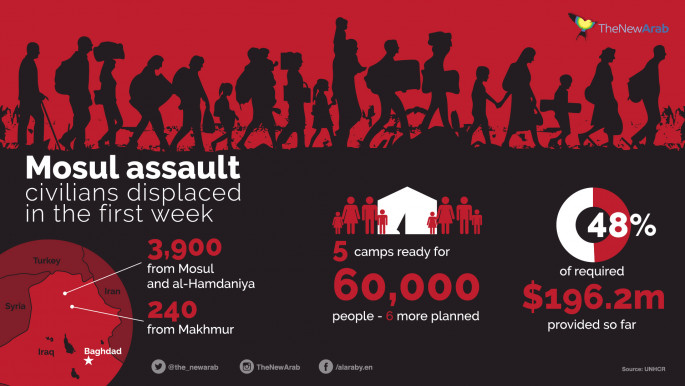'Horror scenario' awaits Mosul civilians as government forces advance
The UN has said that IS has seized tens of thousands of civilians for possible use as human shields in Mosul, and also noted that reports that close to 300 people have been executed in the area since October 25.
Thousands of people have been displaced, meanwhile, since an assault on Mosul lead by the Iraqi army and Kurdish Peshmerga forces began on October 17.
The arrival of Iraqi forces on the outskirts of the city over the last few days have also raised new concerns and expectations of a fresh movement of civilians out of the area.
Iraqi forces are now said to have made progress into Kujakli, an eastern district of the city, with troops also advancing into the south-eastern Judaydat al-Mufti area of Mosul.
On Wednesday, a correspondent with The New Arab’s sister publication noted additionally that Iraqi forces had begun a large-scale offensive to liberate the town of Hamam al-Alil, located 20km south of Mosul. In this process, noted the correspondent, residential areas had been exposed to violent artillery strikes, one of many concerns for observing aid organisations.
Bracing for the worst
"We are now bracing ourselves for the worst. The lives of 1.2 million civilians are in grave danger, and the future of all of Iraq is now in the balance," the Norwegian Refugee Council's Iraq director, Wolfgang Gressmann, said in a statement.
"People in and around Mosul have lived for almost two and a half years in a relentless, terrifying nightmare. We are now all responsible to put an end to it," Gressmann said.
"In the last weeks since the final Mosul operation started, we've seen thousands forced to flee their homes, families separated, many civilians injured and others killed by snipers or by explosive devices."
For its part, in a press release on Wednesday, the International Rescue Committee stressed that keeping civilians out of the firing line must be a priority for Iraqi forces, expressing concern that non-combatants in Mosul could be used as “human shields” by IS.
 |
“They must find a way for people to safely leave the city as quickly as possible, otherwise, hundreds of thousands are at risk of being trapped in the city as the fighting rages around them,” said Alex Milutinovic, IRC Iraq Country Director.
“We must not forget that the vast majority inside Mosul are innocent people who have suffered terribly under the brutal rule of ISIS. In the past week, thousands more from outlying villages have been forced to enter Mosul where ISIS are likely to use them as human shields.”
According to the International Organization for Migration, 20,000 people have been displaced from Mosul and the surrounding environs to date. On Monday, Iraqi Prime Minister Haider al-Abadi delivered a message to the 3,000 to 5,000 militants believed to be in Mosul, which was overrun by IS in June 2014, stating that there was “no escape”, calling on them to “either surrender or die”.
Aid organisations have previously said that their ability to cater for the needs of all people displaced from Mosul could be compromised by considerable aid deficits.
In September the UN’s Office for the Coordination of Humanitarian Assistance (OCHA) announced that the UN’s aid appeal of $861 million for Mosul was less than 40 percent funded.
OCHA has warned that humanitarian efforts in Mosul could cost "as much as $1 billion". Before the start of Iraqi military operations in the city, the UN organisation noted that with as many as one million people estimated to be trapped inside Mosul military operations, it could trigger the “largest humanitarian crisis in the world” in 2016.
 |
With agencies.





 Follow the Middle East's top stories in English at The New Arab on Google News
Follow the Middle East's top stories in English at The New Arab on Google News


